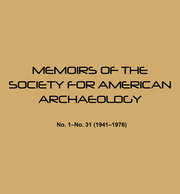Crossref Citations
This article has been cited by the following publications. This list is generated based on data provided by
Crossref.
Rahtz, Philip
1978.
Grave Orientation.
Archaeological Journal,
Vol. 135,
Issue. 1,
p.
1.
Silverman, Helaine
2002.
Introduction: The Space and Place of Death.
Archaeological Papers of the American Anthropological Association,
Vol. 11,
Issue. 1,
p.
1.
Mooder, K.P.
Weber, A.W.
Bamforth, F.J.
Lieverse, A.R.
Schurr, T.G.
Bazaliiski, V.I.
and
Savel'ev, N.A.
2005.
Matrilineal affinities and prehistoric Siberian mortuary practices: a case study from Neolithic Lake Baikal.
Journal of Archaeological Science,
Vol. 32,
Issue. 4,
p.
619.
Pechenkina, Ekaterina A.
and
Delgado, Mercedes
2006.
Dimensions of health and social structure in the early intermediate period cemetery at Villa El Salvador, Peru.
American Journal of Physical Anthropology,
Vol. 131,
Issue. 2,
p.
218.
Close, A.E.
and
Minichillo, T.
2010.
Neolithic tombs in southwestern Sinai.
Journal of Arid Environments,
Vol. 74,
Issue. 7,
p.
829.
Kovtun, S.P.
2010.
SOCIAL STRUCTURE OF THE EARLY MEDIEVAL POPULATION IN THE UPPER KAMA REGION (BASED ON EVIDENCE FROM THE NEVOLINO BURIAL SITES OF THE 4TH–9TH CENTURIES).
Archaeology, Ethnology and Anthropology of Eurasia,
Vol. 38,
Issue. 1,
p.
44.
2011.
Wiley‐Blackwell Encyclopedia of Human Evolution.
p.
1.
Milisauskas, Sarunas
2011.
European Prehistory.
p.
153.
Strauss, André
2012.
Possibilidades e limitações interpretativas da Hipótese Saxe/Goldstein.
Boletim do Museu Paraense Emílio Goeldi. Ciências Humanas,
Vol. 7,
Issue. 2,
p.
525.
Holobinko, Anastasia
2012.
Theoretical and Methodological Approaches to Understanding Human Migration Patterns and their Utility in Forensic Human Identification Cases.
Societies,
Vol. 2,
Issue. 2,
p.
42.
Baxter, Jane Eva
2013.
Status, Sentimentality and Structuration: An Examination of ‘Intellectual Spaces’ for Children in the Study of America’s Historic Cemeteries.
Childhood in the Past,
Vol. 6,
Issue. 2,
p.
106.
Santana, J.
Velasco, J.
Balbo, A.
Iriarte, E.
Zapata, L.
Teira, L.
Nicolle, C.
Braemer, F.
and
Ibáñez, J.J.
2015.
Interpreting a ritual funerary area at the Early Neolithic site of Tell Qarassa North (South Syria, late 9th millennium BC).
Journal of Anthropological Archaeology,
Vol. 37,
Issue. ,
p.
112.
Watson, James T.
Cerezo-Román, Jessica I.
Maldonado, Lic. Silvia I.N.
Guzmán, Lic. Carlos C.
and
Villalpando, Lic. M. Elisa
2015.
The Analysis of Burned Human Remains.
p.
339.
Solé, Alex
Picornell, Llorenç
Allué, Ethel
and
Fullola, Josep Maria
2016.
How did the dead turn up to the burial? A technological and experimental approach to the late Bronze Age wooden biers from Cova des Pas (Minorca, Balearic Islands).
Archaeological and Anthropological Sciences,
Vol. 8,
Issue. 4,
p.
849.
Watson, James T.
and
Phelps, Danielle O.
2016.
Violence and Perimortem Signaling among Early Irrigation Communities in the Sonoran Desert.
Current Anthropology,
Vol. 57,
Issue. 5,
p.
586.
Palomo, Juan Manuel
Inomata, Takeshi
and
Triadan, Daniela
2017.
MORTUARY RITUALS AND CRANIAL MODIFICATIONS AT CEIBAL: FROM THE EARLY MIDDLE PRECLASSIC TO THE TERMINAL CLASSIC PERIOD.
Ancient Mesoamerica,
Vol. 28,
Issue. 1,
p.
305.
Ahola, Marja
2017.
Memory, Landscape & Mortuary Practice.
Acta Archaeologica,
Vol. 88,
Issue. 1,
p.
95.
Ensor, Bradley E.
Irish, Joel D.
and
Keegan, William F.
2017.
The Bioarchaeology of Kinship: Proposed Revisions to Assumptions Guiding Interpretation.
Current Anthropology,
Vol. 58,
Issue. 6,
p.
739.
Yeshurun, Reuven
2018.
Taphonomy of old archaeofaunal collections: New site-formation and subsistence data for the Late Paleolithic Nile Valley.
Quaternary International,
Vol. 471,
Issue. ,
p.
35.
Sawchuk, Elizabeth A.
Goldstein, Steven T.
Grillo, Katherine M.
and
Hildebrand, Elisabeth A.
2018.
Cemeteries on a moving frontier: Mortuary practices and the spread of pastoralism from the Sahara into eastern Africa.
Journal of Anthropological Archaeology,
Vol. 51,
Issue. ,
p.
187.


